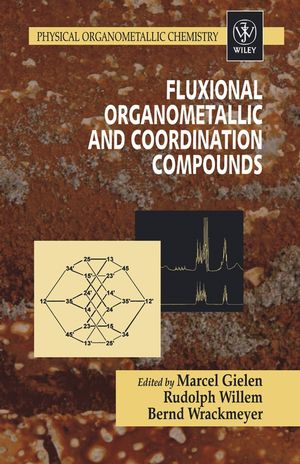Fluxional Organometallic and Coordination CompoundsISBN: 978-0-470-85839-4
Hardcover
340 pages
October 2008
 This is a Print-on-Demand title. It will be printed specifically to fill your order. Please allow an additional 15-20 days delivery time. The book is not returnable.
|
||||||
Series Preface.
Preface.
1. Polyhedral Dynamics and the Jahn–Teller Effect (R. Bruce King).
1. Introduction.
2. Polyhedron Topology.
3. Polyhedral Isomerizations: Microscopic Models.
3.1 Diamond–Square–Diamond Processes.
3.2 Gale Diagrams.
3.3 Generation of Metallaborane Structures by Diamond–Square–Diamond Transformations in Deltahedra.
4. Polyhedral Isomerizations: Macroscopic Models.
4.1 Topological Representations of Polyhedral Isomerizations.
4.2 Topological Representations of Jahn–Teller Distortions.
5. Acknowledgement.
6. References.
2. NMR Studies of Intramolecular Dynamics in Allylic Type Triorganoboranes (I. D. Gridnev and O. L. Tok).
1. Introduction.
2. Discovery Activation Parameters of [1,3]-B Shifts.
3. Fluxional Linear Polyunsaturated Allylboranes.
3.1 2,4-Pentadienyl(di-n-propyl)borane.
3.2 2,4,6-Heptatrienyl(di-n-propyl)borane.
4. DynamicBeha vior of CyclicAll ylboranes.
4.1 Dynamic Equilibria Between 2-(Dialkylboryl)methylenecyclobutanes
and 1-(Dialkylboryl)cyclobutenes.
4.2 DynamicPr operties of Cyclopentadienyl and Pentamethylcyclopentadienyl Derivatives of Boron.
4.3 Synthesis and DynamicPr operties of 1-Indenyl(diethyl)borane.
4.4 DynamicBeha vior of Cycloheptadienyl(di-n-propyl) borane.
4.5 Synthesis and DynamicPr operties of Cycloheptatrienyl(di-npropyl) borane. Equilibrium with 7-(Di-n-propylboryl)norcaradiene.
4.6 Three Independent Dynamic Processes in the Irontricarbonyl Complex of Cycloheptatrienyl(di-n-propyl)borane.
4.7 Cyclooctatetraenyl(di-n-propyl)borane.
4.8 SigmatropicMigr ations and Thermal Rearrangements in Cyclononatetraenyl(di-n-propyl)borane. Comparison with the DynamicPr operties of Cyclononatetraenyl(trimethyl)tin.
4.9 BorotropicMigr ations in Phenalenyl(di-n-propyl)borane 24.
5. Diverse Chemoselectivity of Cyclic Polyunsaturated Organoboranes.
5.1 Chemical Behavior of Borane 23.
5.2 Diverse Chemoselectivity of 9-Cyclopentyl-9-borabarbaralane 54e.
6. Conclusion.
7. References.
3. Dynamic Behavior of Group 5 and 6 Transition Metal Complexes with NMR (S. Sakharov).
1. Introduction.
2. Rotational Isomerism in Amido and Ketimido Complexes.
2.1 Rotational Isomerism in Oxofluoramido Complexes of Tungsten(VI).
2.2 Restricted M–NR2 Rotation in the Dinuclear Complexes with M26+ Core (M =W,Mo).
2.3 Features of DynamicBeha vior of Amido Cyclopentadienyl
Complexes of Group 5 Transition Metals.
2.4 Internal Hindered Rotation of Ketimido Ligands.
3. DynamicBeha vior of d0 Transition Metal Complexes with n-Donor Two-Center Ligands.
3.1 Isomerization of Fluorocomplexes of Group 5–6 with O, N-Two-Center Ligands.
3.2 Isomerism of Transition Metal Complexes with N, N-Two-center Ligands.
3.3 Nature of Bonding of n-Donor Two-center Ligands in d0 Transition Metal Complexes.
3.4 Mechanism of Internal Hindered Rotation of _2-Bound Ligands.
4. Conclusion.
5. References.
4. Conformational Mobility in Chelated Square-planar Rh, Ir, Pd, and Pt Complexes (P. Espinet and J. A. Casares).
1. Introduction.
2. Conformational Changes in Five-member Metallacycles.
3. Conformational Changes in Six-member Metallacycles.
4. Conformational Changes in Five- or Six-member Metallacycles Involving Coordinated Olefins.
5. Conformational Changes in Seven-member Metallacycles.
6. Conformational Changes in Higher Metallacycles.
7. Acknowledegment.
8. References.
5. Dynamic and Kinetic Aspects of Metallodrugs by NMR (F. Li and H. Sun).
1. Introduction.
2. Methods of Study by NMR.
3. Platinum Anticancer Drugs.
3.1 195Pt, 15N and Inverse [1H, 15N] NMR Spectroscopy.
3.2 Activation of Platinum Anticancer Drugs: Kinetics and Equilibria of Aquation.
3.3 Platination of Nucleotides and DNA.
3.4 Interaction of Platinum Agents with Amino Acids, Peptides and Proteins.
4. Titanium and Ruthenium Anticancer Agents.
5. Gold Antiarthritic Drugs.
6. Antimony Antiparasitic and Bismuth Antiulcer Drugs.
7. Vanadium Antidiabetic Mimetics.
8. MRI Contrast Agents.
9. Concluding Remarks.
10. Abbreviations.
11. Acknowledgements.
12. References.
6. Dynamics by EPR: Picosecond to Microsecond Time Scales (S. Van Doorslaer and G. Jeschke).
1. Introduction.
2. Scope of EPR Spectroscopy.
2.1 Native Paramagnetic Centers.
2.2 Spin Labels and Spin Probes.
3. A Brief Primer on EPR Spectroscopy.
3.1 Interactions of Electron Spins with Their Environment.
3.2 Relaxation.
3.3 Measurement Techniques.
4. Detection of Dynamic Processes by EPR.
4.1 Slow Tumbling.
4.2 Exchange Processes.
4.3 Dynamic Jahn–Teller Effect.
4.4 Chemically Induced Dynamic Electron Polarization (CIDEP).
5. Application Example: How to Combine Different EPR Techniques.
6. Acknowledgements.
7. References.
7. μSR Studies of Molecular Dynamics in Organometallics (U. A. Jayasooriya).
1. Introduction.
2. Muon.
3. Muon in Matter.
4. Experiment.
5. Muon in a Longitudinal MagneticField.
6. Muon–Electron (Muonium Like) System.
7. Molecular Dynamics.
8. Studies of Organometallics.
8.1 Tetraphenyl Metals.
8.2 Benzene Chromium Tricarbonyl.
8.3 Cyclopentadienyl Manganese Tricarbonyl.
8.4 Ruthenocene.
8.5 Ferrocene.
8.6 Ferrocene Encapsulated in Zeolite.
9. Conclusion.
9. Acknowledgements.
10. References.
8. Proton Dynamics in Solids: Vibrational Spectroscopy with Neutrons (F. Fillaux).
1. Introduction.
2 .Vibrational Spectroscopy Techniques.
2.1 Some Definitions.
2.2 Optical Techniques.
2.3 Neutron Scattering Techniques.
2.4 Potassium Hydrogen Bistrifluoroacetate.
3. Vibrational Dynamics of Protons in Solids.
3.1 Force-Field Calculations: Normal versus Localized Modes.
3.2 The Proton Crystal Model.
4. Tunnelling.
4.1 Proton Transfer.
4.2 Rotational Tunnelling.
5. Conclusions.
6. References.
Index.



